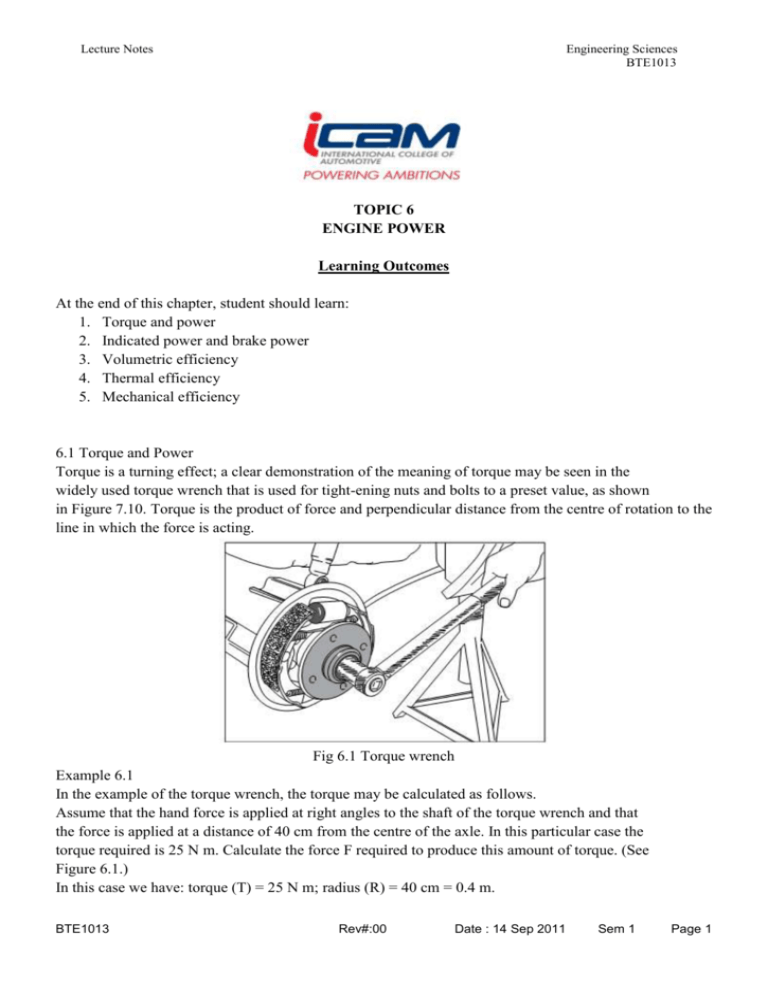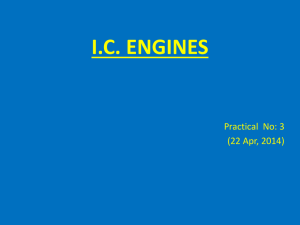LECTURE NOTES BTE1013 ENGINE POWER Sep2012
advertisement

Lecture Notes Engineering Sciences BTE1013 TOPIC 6 ENGINE POWER Learning Outcomes At the end of this chapter, student should learn: 1. Torque and power 2. Indicated power and brake power 3. Volumetric efficiency 4. Thermal efficiency 5. Mechanical efficiency 6.1 Torque and Power Torque is a turning effect; a clear demonstration of the meaning of torque may be seen in the widely used torque wrench that is used for tight-ening nuts and bolts to a preset value, as shown in Figure 7.10. Torque is the product of force and perpendicular distance from the centre of rotation to the line in which the force is acting. Fig 6.1 Torque wrench Example 6.1 In the example of the torque wrench, the torque may be calculated as follows. Assume that the hand force is applied at right angles to the shaft of the torque wrench and that the force is applied at a distance of 40 cm from the centre of the axle. In this particular case the torque required is 25 N m. Calculate the force F required to produce this amount of torque. (See Figure 6.1.) In this case we have: torque (T) = 25 N m; radius (R) = 40 cm = 0.4 m. BTE1013 Rev#:00 Date : 14 Sep 2011 Sem 1 Page 1 Lecture Notes Engineering Sciences BTE1013 T=F×R F=T÷R F = 25 N m 0.4 m F = 62.5 N Power Power is the rate of doing work, i.e. power = work done in joules time taken in seconds Power is measured in watts (W) Power P in watts = work done in joules time taken in seconds 6.2 Indicated power (i.p.) and brake power (b.h.p.) Indicated power (i.p.) is the power that is developed inside the engine cylinders. It is determined by measuring the pressures inside the cylinders while the engine is on test, on a dynamometer. Because the pressure varies greatly throughout one cycle of operation of the engine, the pressure that is used to calculate indicated power is the mean effective pressure. Calculation of indicated power Indicated power is calculated from the formula Indicated power (ip) = (P ×l×a×N)/1000 Unit as kW where P = mean effective pressure in N/m2, l = length of engine stroke in m, a = cross sectional area of cylinder bore in m2, N = number of working strokes per second. Brake power The engine power that actually reaches the output shaft or flywheel of an engine is known as the brake power. It is the power that is measured by a dynamometer and a dynamometer is also known as a brake, hence the term, brake power. BTE1013 Rev#:00 Date : 14 Sep 2011 Sem 1 Page 2 Lecture Notes Engineering Sciences BTE1013 Work done per revolution of the flywheel = force × distance = (W−S)×2R joules (W−S×R also = T the torque that the engine is exerting. By substituting T for W−S×R the) work done per revolution becomes = T×2 joules 6.3 Volumetric efficiency 6.4 Thermal efficiency 6.5 Mechanical efficiency BTE1013 Rev#:00 Date : 14 Sep 2011 Sem 1 Page 3 Lecture Notes BTE1013 Engineering Sciences BTE1013 Rev#:00 Date : 14 Sep 2011 Sem 1 Page 4







